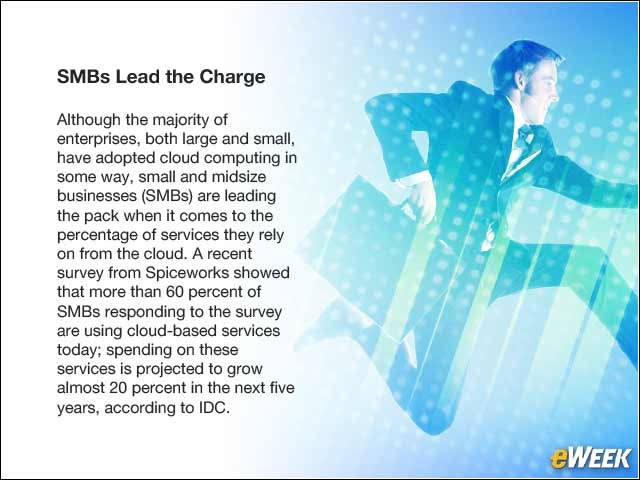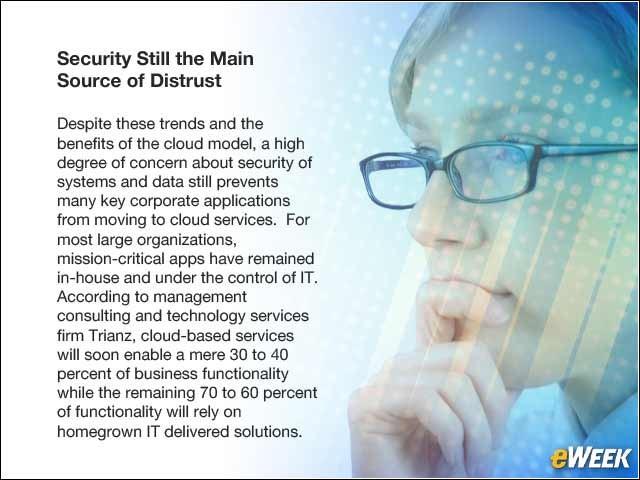eWEEK content and product recommendations are editorially independent. We may make money when you click on links to our partners. Learn More.
2SMBs Lead the Charge
Although the majority of enterprises, both large and small, have adopted cloud computing in some way, small and midsize businesses (SMBs) are leading the pack when it comes to the percentage of services they rely on from the cloud. A recent survey from Spiceworks showed that more than 60 percent of SMBs responding to the survey are using cloud-based services today; spending on these services is projected to grow almost 20 percent in the next five years, according to IDC.
3Clouds Getting More Complex to Administer
For many large enterprises, increasing user demand, shorter timelines, the growth of mobile devices and the bring-your-own-device (BYOD) age has resulted in a complex mix of data center infrastructure and public, private and hybrid cloud services by large organizations. In addition, the growth of big data presents a huge challenge in terms of both storage and computing capacity. In response to these variables, the cloud computing benefits of dynamic scalability and pay-as-you-go are driving cloud adoption in large enterprises to help meet these challenges.
4Security Still the Main Source of Distrust
Despite these trends and the benefits of the cloud model, a high degree of concern about security of systems and data still prevents many key corporate applications from moving to cloud services. For most large organizations, mission-critical apps have remained in-house and under the control of IT. According to management consulting and technology services firm Trianz, cloud-based services will soon enable a mere 30 to 40 percent of business functionality while the remaining 70 to 60 percent of functionality will rely on homegrown IT delivered solutions.
5More Clouds Gathering Inside the Firewall
6Federal Mandate Spurring Government Cloud Building
Driven by the 2011 Federal Cloud Computing Strategy initiative, U.S. government agencies are increasingly adopting cloud computing. Recent IDC claims state that, overwhelmingly, these are private clouds. The research firm projects that in 2014 federal spending for private clouds will be $1.7 billion, while public cloud spending will be around $118.3 million.
7Performance, Security Are Key Pain Points for Government Cloud Projects
8Niche Services Become Key Value-Adds
Cloud service providers and managed service providers are finding the market to be highly competitive, and many have difficulties staying profitable, leaving them with the challenge of differentiating themselves through the services they offer. Key value-added services are proving to be security, disaster-recovery and administrative tools, including backup and desktop as a service. We will continue to see many new niche services emerging as a means of helping providers compete in an oversaturated market.
9Hybrid Clouds Will Dominate in the Future
According to a survey by North Bridge Venture Partners and GigaOM, hybrid clouds are forecasted to grow at a considerable rate, and are estimated to become the most prevalent model within five years. At the moment, more private clouds are being planned and built by enterprises, but most of those will become hybrid as time goes on.
10More Key Business Apps Will Be Cloud-Based
11Automation, Easy Configurability: Keys to the Cloud’s Future
To spur future adoption, cloud services must include the following: the ability to seamlessly provision hybrid clouds that include internal and public cloud computing resources; the ability to provision virtual and physical resources to support a broad range of apps, including performance-intensive mission-critical apps; comprehensive functionality to deliver user self-service with a high level of security, availability and management ; and ease of use for end users and the IT personnel who need to implement cloud services.










